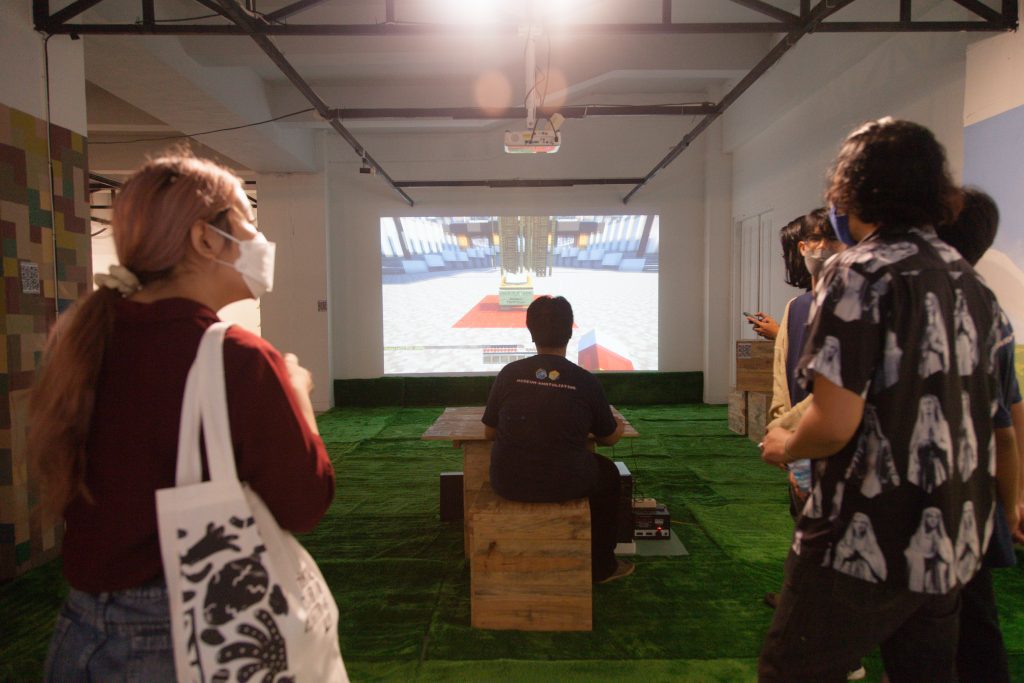“Has it started?”
“Not yet. I’ve also just arrived,” I said when the clock showed 10:55 a.m.
Ayu, a journalist for Radar Jogja, conversed with when we passed in front of the Biennale Secretariat at Taman Budaya Yogyakarta. While busy with their respective devices, Ayu suddenly said, “The program has started.”
It’s true. The clock shows 11:05 a.m. According to the schedule, the Media Preview agenda for the Equator Biennale Archive Exhibition will be held at 11.00 a.m on Tuesday (5/10).
Ayu is just one of the journalists who were invited to watch the Jogja XVI Equator #6 2021 Archive Biennale Exhibition #6 2021 before it officially opens tomorrow.
Other journalists came from various media, including Kompas, Suara Jogja, Daily Jogja, Jogja Istimewa TV, Art Events, Art Posters, and All You Can Art.
The two of us rushed to enter the main door of the Yogyakarta Cultural Park where the event was held. After that, like other media crews, we split up to look for news.
The first room was the orientation of the Archive Exhibition, titled “Game of the Archive.” On the east side, the wall has been transformed into a timeline board, telling the stories of colonialism and decolonization efforts in Southern countries, including Indonesia. From the World Wars to the Asian-African Conference.
Two JITV crews were seen monitoring the timeline partition. One was taking notes, the other recording. “We will broadcast it on television,” said the JITV crew who served as reporters.
“Write down important political events in 2021,” the Archive Exhibition officer offered to me while handing me a pen and sticky note. He thought I must be a media crew.
Because I was reluctant to explain myself, I merely wrote: The demands for the release of Covid-19 vaccine patents by Southern countries. It’s in line with the decolonization timeline on display, right?
After getting separated from Ayu and a pair of JITV crew, I was like a loose baby chicken. Confused, I chose to enter the darkroom. Inside there were only computers, the sound of script reading, and three people talking. It turned out that Alia Swastika, Director of the Yogyakarta Biennale Foundation, was explaining the installation to journalists from Harian Jogja and Kompas.
The sound from the installation, according to Alia’s explanation, was the voice of Bung Karno who was reading the text of the speech “To Build a World a New”. The text, which was read during the 1955 Asian-African Conference (KAA) in Bandung, was processed by an artist using artificial intelligence technology.
“Data about Bung Karno was entered and processed so that it gave rise to a certain voice character,” said Alia. There were also women’s voices that often appear, which also came from Bung Karno’s data supply that mostly revolves around women.

Awak media sedang menyaksikan Museum Khatulistiwa berbasis game.
There’s a silhouette with a fan that’s actually Alia. A moment later, she said, “Let’s go outside if you want to chat. It’s hot in here,” Exiting the darkroom, walk a little, turn right, and we arrived at the “Museum of the Equator”.
It wasn’t just any museum, this place is in the form of a Minecraft game. A creative game that can arrange spaces with a variety of pixel-shaped materials is utilized by the Minecraft Community.
To summarize the 5 editions of the Equator Series Biennale, this interactive digital installation is titled “Museum Equator”. Many journalists were attracted by this installation. Some of them even spent some time to play it.
Hiromi, a journalist for Suara Jogja, was one of the participants in the Media Preview who was impressed by “Museum Khatulistiwa”.
“The reconstruction of a two-dimensional image into a volume with a pixel format makes me shake my head,” he said, widening his eyes.
To him, the fact that such a good appearance and gameplay can be made in just a month is something that adds to the special impression of the “Museum of the Equator”.
After walking around, the journalists sat in a circle around the table. They were asking for information from Alia.
The media crew from Harian Jogja asked about the purpose of the Oceania theme of the XVI Biennale Jogja. Alia answered bluntly that this is an attempt to take a second look at Indonesia, but from the east side.
“The center and periphery in art is a matter of access. Through the Biennale Equator, we are increasingly realizing that every artwork from different places in the world has its value,” she replied.
Likewise at the XVI Jogja Biennale that brought together Indonesia and Oceania. Artists from Eastern Indonesia with an intensive network with the cultural context of Oceania, said Alia, has an equally important role in building the history of Indonesian art.
“Just technical thing, how about visiting the Biennale exhibitions?” asked the Harian Jogja’s reporter.
“First, you need to register through the Biennale Jogja website. Registration starts on October 10 and the exhibition opens to the public the next day,” answered Alia.
The registration scheme, added Alia, is due to the adaptation of new habits in the current Covid-19 pandemic. There are 3 sessions per day with a maximum of 50 visitors per session.
The Media Preview session ends at 12.00 p.m. Each journalist returned to their respective activities.
Some immediately wrote articles, like Hiromi. “Three articles in one Media Preview,” he said.
There are also those like Ayu. Immediately rushed out of the showroom. I followed while asking, “Where are you going?”
More coverage, she replied, walking away.
Ah, often, reporting is the silence of each (journalist).